
5740G Patek Philippe Nautilus Perpetual Calendar
Almost as soon as the Royal Oak was born, it became complicated. For the Nautilus, and indeed Overseas, this couldn’t be further from the case. It took until 1998 for the Nautilus to sport its first complication, a humble power reserve under 12 alone in the ref. 3710. That’s all. We didn’t see more complication until the ref. 3712 in 2005: just a straightforward moonphase, power reserve, and date. Somewhat astonishingly, we didn’t see a calendar until the 2010 ref. 5726 and it was not the full monty, but an Annual. In 2018, a full 43 years after AP’s 5554, Patek Philippe finally brought out the full QP. This is that Perpetual Calendar, the. 5740, and though late to the party it showed up ready to scrap. True classic high complication in a Nautilus case at last.


It wasn’t even a particularly hard job either, the 5140 had a beautiful and thin (just 3.88mm) 240Q ready to go. That is one of those calibres which has survived in many platforms mercifully mostly unaltered in the shift from Geneva Seal to Patek Seal. The dial is quite strong departure from the arguably more expressive prior calendar, 5726. First, the Patek signature keeps growing. Initially, it used to fit on one rib of the hard carved Stern dial. Now it has a little plaque with much lighter ribber. The format is classic 3940 in layout, which is no bad thing. The corrector pushers ingeniously are way out on the lugs, with some interesting levers to avoid interrupting the ‘ear’ design. And of course, it’s white gold. I like the sole red use for the first of the month more than I should.
It is simply too early for history to have judged the 5740. Perhaps it is simply too late to be revered in the same way that Royal Oak QP lineage is, though currently selling over double RRP. Purely on the dial spacing and tone, the 240Q does seem more suited to a less sporting case. There’s a bit of cluttering, particularly on the cut-off edge of the 2, 4, 8, and 10 markers, but it’s well-managed enough. Is it as beautiful as its peers? That’s up to you. The market tells us it’s significantly desirable. But I’m very curious to see how it ages to be regarded in the coming decades. Were Patek waiting and learning, preparing to decimate their peers like Spartan ambush? Or did they simply wait so long that the competition has moved on? That’s up to us.

This example sports a little to no wear, at least that I can see. The clasp still has its stickers. It has the full kit, coming from a well-regarded London retailer.








